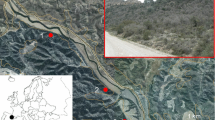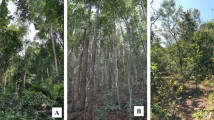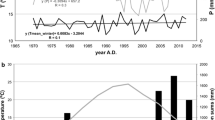Abstract
Background and aims
Drought-associated vegetation declines are increasingly observed worldwide. We investigated whether differences in water relations can potentially explain the distribution and vulnerability to drought-induced decline of four common tree species in Mediterranean southwestern Australia.
Methods
We compared seasonal and daily water relations of four eucalypt species (i.e. C. calophylla, E. accedens, E. marginata, E. wandoo) when co-occurring as well as on nearby typical sites for each species.
Results
When co-occurring, species generally inhabiting drier regions (i.e. E. accedens, E. wandoo) had lower summer leaf water potentials, osmotic potential, and vulnerability to cavitation and higher stomatal conductance and relative sapflow velocity. Both wetter zone species (e.g. C. calophylla and E. marginata) had remarkably high vulnerabilities to cavitation for Mediterranean woody species but showed greatly improved leaf water status on nearby sites where they dominate. Using local soil moisture retention curves of saprolitic clay layers underlying southwestern Australia we show the large disadvantage that the wetter zone species have in terms of accessing tightly bound water in these layers.
Conclusions
Our work shows that species distribution and local dominance of four dominant overstorey species in southwestern Australia is largely a function of plant water relations interacting with local soil profiles. The observed differences in water relations amongst species are consistent with some of the declines that have been observed in recent decades.







Similar content being viewed by others
References
Ackerly D (2004) Functional strategies of chaparral shrubs in relation to seasonal water deficit and disturbance. Ecol Monogr 74:25–44
Allen CD, Macalady AK, Chenchouni H, Bachelet D, McDowell N, Vennetier M, Kitzberger T, Rigling A, Breshears DD, Hogg EH, Gonzalez P, Fensham R, Zhang Z, Castro J, Demidova N, Lim J-H, Allard G, Running SW, Semerci A, Cobb N (2010) A global overview of drought and heat-induced tree mortality reveals emerging climate change risks for forests. Forest Ecol Manag 259:660–684
Anand RR, Paine M (2002) Regolith geology of the Yilgarn Craton, Western Australia: implications for exploration. Austral J Earth Sci 49:3–162
Bartlett MK, Scoffoni C, Sack L (2012) The determinants of leaf turgor loss point and prediction of drought tolerance of species and biomes: a global meta–analysis. Ecol Lett 15:393–405
Bates BC, Hope P, Ryan B, Smith I, Charles S (2008) Key findings from the Indian Ocean Climate Initiative and their impact on policy development in Australia. Clim Chang 89:339–354
Beard JS (1990) Plant life of Western Australia. Kangaroo Press, Kenthurst
Bell DT, Williams JE (1997) Eucalypt ecophysiology. In: Williams JE, Woinarski JCZ (eds) Eucalypt ecology: individuals to ecosystems. Cambridge University Press, Cambridge, pp 168–196
Bhaskar R, Ackerly DD (2006) Ecological relevance of minimum seasonal water potentials. Physiol Plantarum 127:353–359
Boland DJ, Brooker MIH, Chippendale GM, Hall N, Hyland BPM, Johnston RD, Kleinig DA, McDonald MW, Turner JD (2006) Forest trees of Australia. CSIRO Publishing, Collingwood
Bréda N, Huc R, Granier A, Dreyer E (2006) Temperate forest trees and stands under severe drought: a review of ecophysiological responses, adaptation processes and long-term consequences. Ann For Sci 63:625–644
Brooker MIH, Hopper SD (1991) A taxonomic revision of Eucalyptus wandoo, E. redunca, and allied species (Eucalyptus series Levispermae Maiden: Myrtaceae) in Western Australia. Nuytsia 8:1–189
Bucci SJ, Scholz FG, Goldstein G, Meinzer FC, Sternberg LDL (2003) Dynamic changes in hydraulic conductivity in petioles of two savanna tree species: factors and mechanisms contributing to the refilling of embolized vessels. Plant Cell Environ 26:1633–1645
Burgess SSO, Adams MA, Turner NC, Beverly CR, Ong CK, Khan AAH, Bleby TM (2001) An improved heat pulse method to measure low and reverse rates of sap flow in woody plants. Tree Physiol 21:589–598
Carbon BA, Bartle GA, Murray AM, Macpherson DK (1980) The distribution of root length and the limits to flow of soil water to roots in a dry sclerophyll forest. Forest Sci 26:656–664
Chave J, Coomes D, Jansen S, Lewis SL, Swenson NG, Zanne AE (2009) Towards a worldwide wood economics spectrum. Ecol Lett 12:351–366
Colquhoun IJ, Ridge RW, Bell DT, Loneragan WA, Kuo J (1984) Comparative studies in selected species of Eucalyptus used in rehabilitation of the Northern Jarrah Forest, Western Australia. I. Patterns of xylem pressure potential and diffusive resistance of leaves. Aust J Bot 32:367–373
Crombie DS (1997) Water relations of jarrah (Eucalyptus marginata) regeneration from the seedling to the mature tree and of stump coppice. Forest Ecol Manag 97:293–303
Crombie DS, Tippett JT, Hill TC (1988) Dawn water potential and root depth of trees and understorey species in southwestern Australia. Aust J Bot 36:621–631
Dell B, Bartle JR, Tacey WH (1983) Root occupation and root channels of jarrah forest subsoils. Aust J Bot 31:615–627
Doley D (1967) Water relations of Eucalyptus marginata Sm. under natural conditions. J Ecol 55:597–614
Donovan L, Linton M, Richards J (2001) Predawn plant water potential does not necessarily equilibrate with soil water potential under well-watered conditions. Oecologia 129:328–335
Franks PJ, Drake PL, Froend RH (2007) Anisohydric but isohydrodynamic: seasonally constant plant water potential gradient explained by a stomatal control mechanism incorporating variable plant hydraulic conductance. Plant Cell Environ 30:19–30
Gentilli J (1989) Climate of the Jarrah Forest. In: Dell B, Havel JJ, Malajczu N (eds) The jarrah forest: a complex Mediterranean ecosystem. Kluwer Academic Publishers, Dordrecht, pp 23–40
George R, Clarke J, English P (2008) Modern and palaeogeographic trends in the salinisation of the Western Australian Wheatbelt: a review. Aust J Soil Res 46:751–767
Hanks LM, Paine TD, Millar JG, Campbell CD, Schuch UK (1999) Water relations of host trees and resistance to the phloem-boring beetle Phoracantha Semipunctata. Oecologia 119:400–407
Havel JJ (2000) Ecology of the forests of South Western Australia in relation to climate and landforms. Dissertation, Murdoch University
Hill KD, Johnson LAS (1995) Systematic studies in the eucalypts. 7. A revision of the bloodwoods, genus Corymbia (Myrtaceae). Telopea 6:185–504
Hooper RJ (2009) The role of stress and factors contributing to the decline of Eucalyptus wandoo (Blakely) in southwestern Australia. Dissertation, University of Western Australia
Hooper RJ, Sivasithamparam K (2005) Characterization of damage and biotic factors associated with the decline of Eucalyptus wandoo in Southwest Western Australia. Can J Forest Res 35:2589–2602
Hopper SD (2009) OCBIL theory: towards an integrated understanding of the evolution, ecology and conservation of biodiversity on old, climatically buffered, infertile landscapes. Plant Soil 322:49–86
Huberty AF, Denno RF (2004) Plant water stress and its consequences for herbivorous insects: a new synthesis. Ecology 85:1383–1398
Hughes JD, Petrone KC, Silberstein RP (2012) Drought, groundwater storage and stream flow decline in southwestern Australia. Geophys Res Lett 39:L03408
IPCC (2007) Climate change 2007: synthesis report. Fourth assessment report of the intergovernmental panel on climate change. IPCC, Geneva
Klausmeyer KR, Shaw MR (2009) Climate change, habitat loss, protected areas and the climate adaptation potential of species in Mediterranean ecosystems worldwide. PLoS One 4:e6392
Lamont B (1985) Gradient and zonal analysis of understorey suppression by Eucalyptus wandoo. Plant Ecol 63:49–66
Loneragan WA (1978) A statistical analysis of the vegetation of the Jarrah and Wandoo forests of Western Australia. Dissertation, University of Western Australia
Maherali H, Pockman WT, Jackson RB (2004) Adaptive variation in the vulnerability of woody plants to xylem cavitation. Ecology 85:2184–2199
McCrea AF, Anand RR, Gilkes RJ (1990) Mineralogical and physical properties of lateritic pallid zone materials developed from granite and dolerite. Geoderma 47:33–57
McDowell N, Pockman WT, Allen CD, Breshears DD, Cobb N, Kolb T, Plaut J, Sperry J, West A, Williams DG, Yepez EA (2008) Mechanisms of plant survival and mortality during drought: why do some plants survive while others succumb to drought. New Phytol 178:719–739
Meinzer FC, Johnson DM, Lachenbruch B, McCulloh KA, Woodruff DR (2009) Xylem hydraulic safety margins in woody plants: coordination of stomatal control of xylem tension with hydraulic capacitance. Funct Ecol 23:922–930
Merchant A, Callister A, Arndt S, Tausz M, Adams M (2007) Contrasting physiological responses of six Eucalyptus species to water deficit. Ann Bot 100:1507–1515
Mitchell PJ, Veneklaas EJ, Lambers H, Burgess SSO (2008) Leaf water relations during summer water deficit: differential responses in turgor maintenance and variation in leaf structure among different plant communities in southwestern Australia. Plant Cell Environ 31:1791–1802
Myers N, Mittermeier RA, Mittermeier CG, da Fonseca GAB, Kent J (2000) Biodiversity hotspots for conservation priorities. Nature 403:853–858
Orians GH, Milewski AV (2007) Ecology of Australia: the effects of nutrient–poor soils and intense fires. Biol Rev 82:393–423
Pammenter NW, Van Der Willigen C (1998) A mathematical and statistical analysis of the curves illustrating vulnerability of xylem to cavitation. Tree Physiol 18:589–593
Pfautsch S, Macfarlane C, Ebdon N, Meder R (2012) Assessing sapwood depth and wood properties in Eucalyptus and Corymbia spp. using visual methods and near infrared spectroscopy (NIR). Trees, in press
Pita P, Gascó A, Pardos JA (2003) Xylem cavitation, leaf growth and leaf water potential in Eucalyptus globulus clones under well-watered and drought conditions. Funct Plant Biol 30:891–899
Poorter H, Niinemets U, Poorter L, Wright IJ, Villar R (2009) Causes and consequences of variation in leaf mass per area (LMA): a meta–analysis. New Phytol 182:565–588
Rice KJ, Matzner SL, Byer W, Brown JR (2004) Patterns of tree dieback in Queensland, Australia: the importance of drought stress and the role of resistance to cavitation. Oecologia 139:190–198
Ridge RW, Loneragan WA, Bell DT, Colquhoun IJ, Kuo J (1984) Comparative studies in selected species of Eucalyptus used in rehabilitation of the Northern Jarrah Forest. Western Australia. II. Wood and leaf anatomy. Aust J Bot 32:375–386
Schulte PJ, Hinckley TM (1985) A comparison of pressure-volume curve data analysis techniques. J Exp Bot 36:1590–1602
Schulze E-D, Turner NC, Nicolle D, Schumacher J (2006) Leaf and wood carbon isotope ratios, specific leaf areas and wood growth of Eucalyptus species across a rainfall gradient in Australia. Tree Physiol 26:479–492
Silberstein R, Held A, Hatton T, Viney N, Sivapalan M (2001) Energy balance of a natural jarrah (Eucalyptus marginata) forest in Western Australia: measurements during the spring and summer. Agr Forest Meteorol 109:79–104
Silberstein RP, Aryal SK, Durrant J, Pearcey M, Braccia M, Charles SP, Boniecka L, Hodgson GA, Bari MA, Viney NR, McFarlane DJ (2012) Climate change and runoff in South-Western Australia. J Hydrol, in press
Sperry JS, Saliendra NZ (1994) Intra- and inter-plant variation in xylem cavitation in Betula occidentalis. Plant Cell Environ 17:1233–1241
Sperry JS, Hacke UG, Oren R, Comstock JP (2002) Water deficits and hydraulic limits to leaf water supply. Plant Cell Environ 25:251–263
Stoneman GL, Turner NC, Dell B (1994) Leaf growth, photosynthesis and tissue water relations of greenhouse-grown Eucalyptus marginata seedlings in response to water deficits. Tree Physiol 14:633–646
Stoneman GL, Crombie DS, Whitford K, Hingston FJ, Giles R, Portlock CC, Galbraith JH, Dimmock GM (1997) Growth and water relations of Eucalyptus marginata (jarrah) stands in response to thinning and fertilization. Tree Physiol 17:267–274
Szota C, Farrell C, Koch JM, Lambers H, Veneklaas EJ (2011) Contrasting physiological responses of two co-occurring eucalypts to seasonal drought at restored bauxite mine sites. Tree Physiol 31:1052–1066
Tognetti R, Longobucco A, Raschi A (1998) Vulnerability of xylem to embolism in relation to plant hydraulic resistance in Quercus pubescens and Quercus ilex co-occurring in a Mediterranean coppice stand in central Italy. New Phytol 139:437–447
Turner NC (1988) Measurement of plant water status by the pressure chamber technique. Irrigation Sci 9:289–308
Warren CR, Bleby T, Adams MA (2007) Changes in gas exchange versus leaf solutes as a means to cope with summer drought in Eucalyptus marginata. Oecologia 154:1–10
White DA, Turner NC, Galbraith JH (2000) Leaf water relations and stomatal behavior of four allopatric Eucalyptus species planted in Mediterranean southwestern Australia. Tree Physiol 20:1157–1165
Whitehead D, Beadle CL (2004) Physiological regulation of productivity and water use in Eucalyptus: a review. Forest Ecol Manag 193:113–140
Zeppel M, Tissue D, Taylor D, Macinnis-Ng C, Eamus D (2010) Rates of nocturnal transpiration in two evergreen temperate woodland species with differing water-use strategies. Tree Physiol 30:988–1000
Acknowledgments
We would like to thank the many people that have assisted in the field and lab work, or that have contributed through engaging in stimulating discussions, including Koen Antonise, Martin Bader, Tim Bleby, Steve Burgess, Eleftheria Dalmaris, Werther Guidi, Mike Oatham, Fabiano Scarpa & Perry Swanborough. This research was supported by Australian Research Council Linkage grant LP0347692, with additional financial support from the Western Australian Department of Environment and Conservation.
Author information
Authors and Affiliations
Corresponding author
Additional information
Responsible Editor: Rafael S. Oliveira.
Electronic supplementary material
Below is the link to the electronic supplementary material.
Online Resource 1
Detailed experimental site descriptions (PDF 21 kb)
Online Resource 2
Detailed xylem vulnerability curve protocol used (PDF 19 kb)
Rights and permissions
About this article
Cite this article
Poot, P., Veneklaas, E.J. Species distribution and crown decline are associated with contrasting water relations in four common sympatric eucalypt species in southwestern Australia. Plant Soil 364, 409–423 (2013). https://doi.org/10.1007/s11104-012-1452-8
Received:
Accepted:
Published:
Issue Date:
DOI: https://doi.org/10.1007/s11104-012-1452-8




